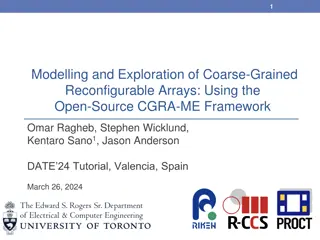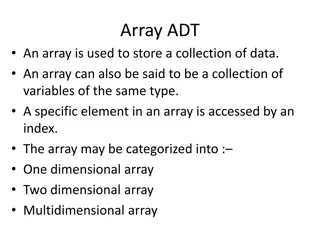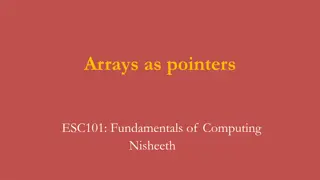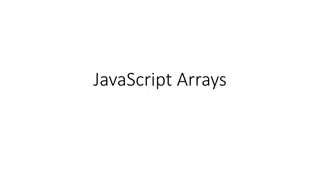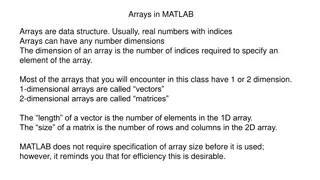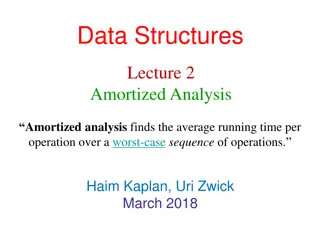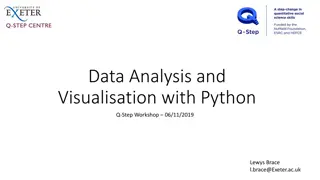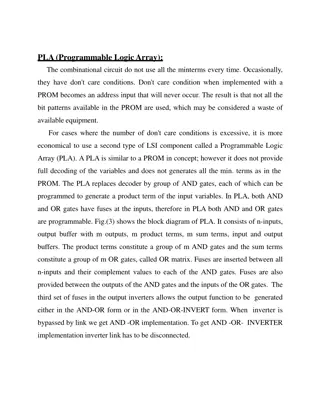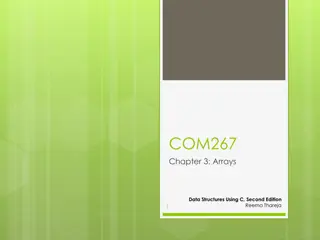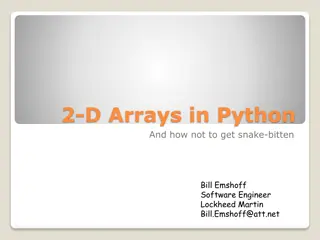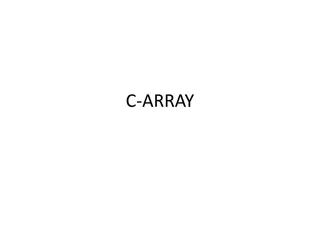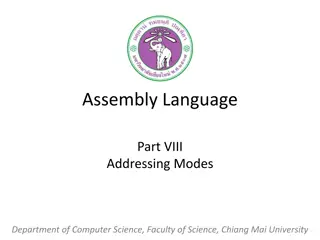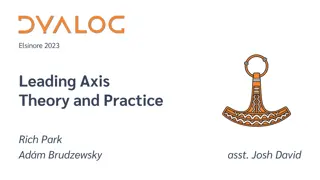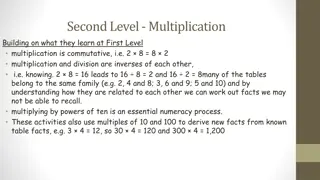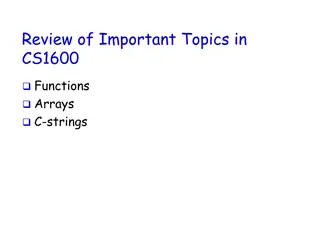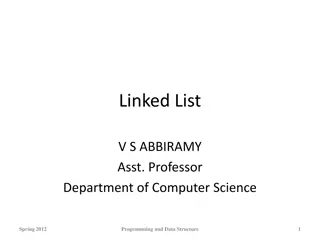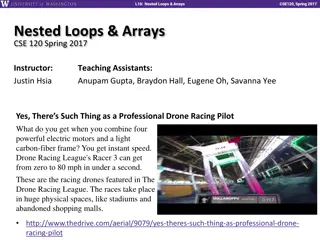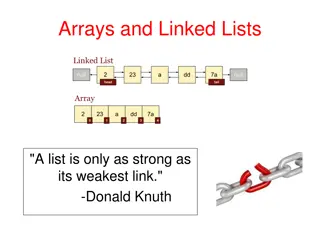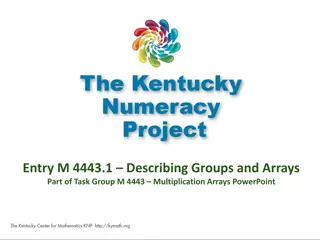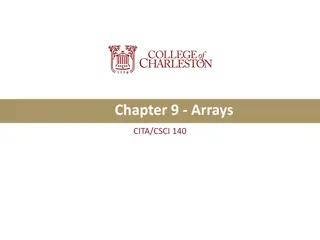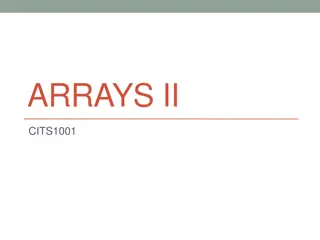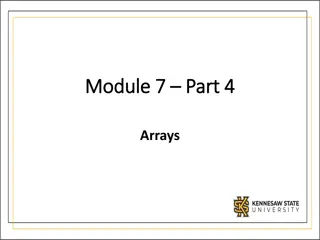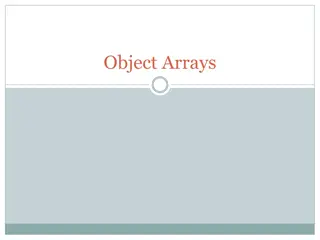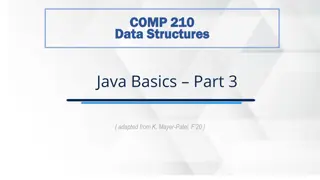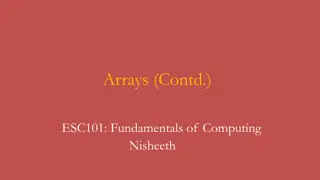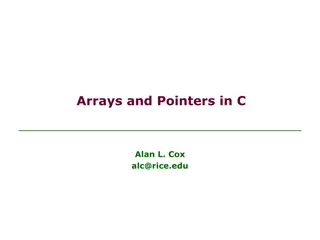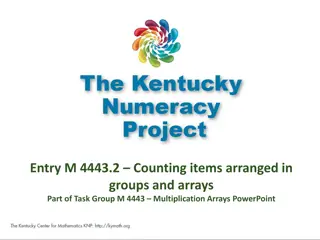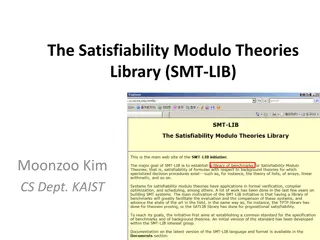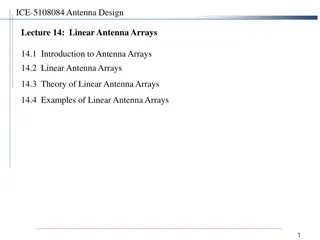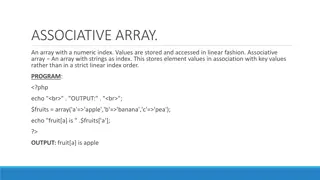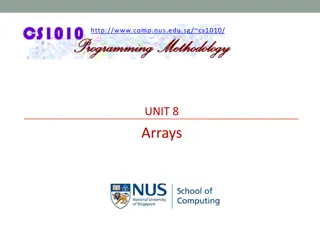Understanding Pointers and Functions in C++ Lecture
Exploring the concept of pointers and functions in C++, this lecture covers the basics of functions, passing arrays to functions, and understanding how pointers can be used in functions to manipulate data. Attendees will learn about passing entire arrays and returning multiple values using pointers.
10 views • 45 slides
Modelling and Exploration of Coarse-Grained Reconfigurable Arrays Using CGRA-ME Framework
This content discusses the CGRA-ME framework for modelling and exploration of Coarse-Grained Reconfigurable Arrays (CGRA). It covers the objectives, architecture description, inputs required, and tools included in the framework. CGRA-ME allows architects to model different CGRA architectures, map ap
2 views • 33 slides
Evolution of Mathematical Theories and Proof Systems
Development of mathematical theories such as model theory, proof theory, set theory, recursion theory, and computational complexity is discussed, starting from historical perspectives with Dedekind and Peano to Godel's theorems, recursion theory's golden age in the 1930s, and advancements in proof t
1 views • 29 slides
Understanding Arrays: Overview and Examples
Arrays are essential data structures used to store collections of data in programming. They can be one-dimensional, two-dimensional, or multidimensional, accessed by specific indices. Learn about linear arrays, indexing methods, and two-dimensional arrays through detailed explanations and visual rep
1 views • 33 slides
Understanding the Theory of Firms: Neoclassical vs. Modern Approaches
The theory of firms is explored through the Neoclassical and Modern perspectives. Neoclassical theory focuses on profit maximization, while Modern theory delves into managerial, principal-agent, and transaction cost theories. The discussion covers criticisms of Neoclassical theory and the essential
1 views • 79 slides
Arrays as Pointers: Fundamentals of Computing
Explore the concept of using arrays as pointers in the context of computing. Learn how to create array of char pointers to store multiple strings, access elements in arrays of pointers, and understand the rules for accessing individual elements. Discover the nuances of pointer manipulation and array
1 views • 10 slides
Working with JavaScript Arrays: Storing and Accessing Data
Arrays in JavaScript serve as containers to hold multiple values like strings, numbers, and booleans within a single variable. They provide a more efficient way to store and manage data compared to using individual variables for each value. The guide covers creating arrays, initializing them, access
0 views • 13 slides
Understanding Arrays in MATLAB for Efficient Data Handling
Explore how arrays in MATLAB are used to store real numbers with indices, including vectors and matrices. Learn about row and column vectors, vector input to MATLAB functions, and the efficient usage of for loops for handling data effectively within arrays.
1 views • 8 slides
Understanding Solar PV Components: Cells, Modules, and Arrays
Solar PV components such as cells, modules, and arrays play a crucial role in converting sunlight into electricity. This unit covers basic terms related to solar PV components, including solar cells, P/N junctions, cell output, various cell constructions, and cell wiring configurations. Explore the
1 views • 15 slides
Understanding Arrays and Number Relationships for Learning Math
Explore the concepts of arrays, commutativity, factors, primes, squares, and multiplication strategies for building arrays. Delve into understanding rows, columns, and various ways to calculate products efficiently. Discover how to make arrays using counters and learn about prime numbers and factor
0 views • 10 slides
Amortized Analysis in Data Structures: Insights and Implementations
Amortized analysis plays a crucial role in understanding the average running time per operation in worst-case scenarios for data structures. This content delves into implementing lists using circular arrays with resizing strategies, lazy deletions in singly linked lists, and explores the costs assoc
0 views • 29 slides
Understanding NumPy for Efficient Data Analysis in Python
NumPy is a foundational package for numerical computing in Python, essential for data analysis and machine learning projects. It provides efficient multidimensional arrays for fast arithmetic operations, mathematical functions, tools for data manipulation, and integration with other languages. This
0 views • 76 slides
Understanding Programmable Logic Arrays (PLA)
Programmable Logic Arrays (PLAs) provide a flexible way to implement combinational circuits with don't care conditions efficiently. PLAs use programmable AND and OR gates to generate product terms, offering a more economical solution compared to PROMs for circuits with excessive don't care condition
0 views • 19 slides
Understanding Arrays in Data Structures Using C
Arrays in C are collections of data elements with the same data type stored in consecutive memory locations. This chapter covers array declaration, accessing elements, storing values, operations, passing arrays to functions, pointers, two-dimensional arrays, and more. Arrays are accessed using indic
3 views • 80 slides
Understanding 2D Arrays in Python for Minesweeper Game Implementation
Explore the concept of 2D arrays in Python through the implementation of the Minesweeper game. Learn how to represent game boards, handle lists as arrays, and work with multi-dimensional data structures for efficient game development.
7 views • 17 slides
Understanding Two-Dimensional Arrays in Java Programming
Explore the concept of two-dimensional arrays in Java programming through examples and illustrations. Learn how to declare, create, and initialize two-dimensional arrays efficiently to represent matrices or tables. Discover the benefits of using multi-dimensional arrays for data organization and man
1 views • 25 slides
Understanding One-Dimensional Arrays in C Programming
Arrays in C are collections of variables of the same data type that allow storing a group of data. This article covers the basics of one-dimensional arrays in C, explaining syntax, declaration, initialization, and accessing elements. It also provides examples and a sample program to demonstrate arra
1 views • 26 slides
Evolution of Light Theory: From Wave Theory to Quantum Theory
At the turn of the century, the discovery of the photoelectric effect challenged the wave theory of light, leading to the development of the quantum theory by Max Planck and Albert Einstein. This new theory introduced the concept of discrete energy units known as quanta, bridging the gap between wav
1 views • 62 slides
Understanding Addressing Modes in Assembly Language
This content delves into the intricacies of addressing modes in assembly language, covering topics such as one-dimensional arrays, the DUP operator for defining arrays, and various modes like register, immediate, direct, and register-indirect modes. It explains how operands are specified in differen
2 views • 24 slides
Object-Oriented Programming Concepts Illustrated
Learn about creating and working with arrays, defining functions, and building classes in an object-oriented programming context. Dive into examples like creating arrays of objects, defining arrays with pointers, and designing classes for a publishing company that markets books and audio cassettes.
5 views • 24 slides
Leading Axis Theory and Practice in Array Kingdom 2023
Exploring the concept of Leading Axis Theory and Practice in the Array Kingdom of Elsinore 2023. The discussion covers essential keys like Rank and Dyadic Transpose, Make Functions apply to whole arrays, and Theory Arrays of various ranks. The images provide insights into major cells, leading axes,
0 views • 32 slides
Exploring Advanced Multiplication Concepts Through Arrays and Partitioning
Delve into the intricacies of multiplication through hands-on activities using arrays, partitioning, and understanding the commutative property. Discover how arrays can help visualize multiplication, learn to partition numbers for easier calculations, and grasp the concept of multiplying by powers o
0 views • 17 slides
Understanding Arrays in CS1600: A Comprehensive Review
Working with arrays in CS1600 involves essential concepts like declaring arrays, array variables, variable types, and usage of indexed variables. Arrays provide a structured way to store and process collections of data of the same type efficiently. Mastering array basics is crucial for effective pro
0 views • 83 slides
Comparison between Array and Linked List Data Structures
Linked lists and arrays are commonly used data structures in programming. Linked lists offer flexibility in size changes and efficient rearrangement of elements, while arrays provide direct access to elements based on their index. Linked lists involve pointers connecting elements, allowing for dynam
0 views • 24 slides
Understanding Nested Loops and Arrays in CSE120, Spring 2017
Dive into the world of nested loops and arrays in CSE120 during the Spring semester of 2017. Explore the fascinating concepts of nested loops, for-loop reviews, and arrays through examples and student work showcases. Discover how these fundamental programming elements can be utilized to control sequ
0 views • 22 slides
Theories of Interest in Microeconomics II
Explore various theories of interest in economics, including the Classical Theory, Liquidity Preference Theory by Keynes, Productivity Theory, Abstinence Theory, Time-Preference Theory, Fisher's Time Preference Theory, and the Loanable Fund Theory. These theories offer different perspectives on the
0 views • 6 slides
Understanding Arrays and Linked Lists in Computer Science
Arrays and linked lists are fundamental data structures in computer science. Arrays provide a fixed-size collection, while linked lists offer dynamic sizing. Arrays are efficient for accessing elements but can be inefficient for insertions and deletions. Linked lists, on the other hand, allow for ea
0 views • 42 slides
Understanding Group Structures and Arrays in Multiplication
Explore the foundational concepts of grouping and arrays in multiplication through activities designed to help students describe quantities arranged in equal groups or arrays. Teacher directions, examples for modeling arrays, and additional activity prompts are provided to support students in interp
0 views • 56 slides
Introduction to Arrays in Computer Science
Explore the concept of arrays in computer science, a special type of variable that can hold collections of elements of the same type. Learn about the characteristics of arrays, how to declare and initialize them, and see examples of specifying array sizes. Develop a foundational understanding of arr
0 views • 19 slides
Understanding Arrays of Objects in Programming
This lecture delves into the concept of arrays of objects, showcasing multi-dimensional arrays and discussing the steps involved in handling arrays of primitive types versus arrays of objects in Java programming. It includes insights on declaring, creating, and populating arrays, along with a practi
0 views • 22 slides
Understanding Arrays in Java: Basics and Operations
Java arrays are fixed-size collections that can only hold a single data type. They require manual checking for elements and cannot be sliced like Python lists. Operations such as resizing, searching, printing, comparing, and slicing arrays need to be done manually. Remember, the array size must be d
0 views • 14 slides
Understanding Arrays of Objects and Primitive Types
Arrays of objects provide a way to store and manage multiple instances of complex data types, similar to arrays of primitive types. This content explores the concept of arrays of objects, how to declare and allocate memory for them, and how to work with arrays of primitive types like double and int.
0 views • 25 slides
Basics of Java Arrays and Array Manipulation
Learn about the fundamentals of Java arrays, including initialization, literals, indexing, and the special value of null. Explore how arrays function as reference types and how array cloning can be used to create shallow copies. Understand the implications of passing arrays to methods and how change
0 views • 44 slides
Understanding Arrays in Computer Programming
Arrays in programming are collections of elements that have the same data type. Elements in an array are accessed using integer-valued indices. Arrays inescapably play a crucial role in programming as they allow for efficient storage and manipulation of data. Initialization, declaration, and utiliza
0 views • 14 slides
Understanding Arrays and Pointers in C Programming
Explore the fundamentals of arrays, pointers, and strings in C programs, along with their representation at the machine level. Learn the similarities and differences between these data types and how to effectively use them in C programming. Dive into array indexing, representation, sizes, multi-dime
0 views • 26 slides
Understanding Arrays and Groups in Multiplication
Explore the concept of grouping items in arrays for multiplication through visual representations. Learn to count items in equal groups, write addition sentences, and connect to Common Core standards. Engage students in discussions about organizing and counting dots in arrays to enhance mathematical
0 views • 45 slides
SMT-LIB: The Satisfiability Modulo Theories Library Overview
The Satisfiability Modulo Theories Library (SMT-LIB) is a comprehensive tool for formal reasoning in various supported theories such as arrays, bit vectors, and integer and real arithmetic. It provides a wide range of supported sublogics for precise specifications and verifications. Moonzoo Kim, fro
0 views • 14 slides
Linear Antenna Arrays: Theory and Applications
Introduction to linear antenna arrays, including the concept of distributing radiating elements, combining array elements for specific beam characteristics, and the theory behind linear antenna arrays. Exploring the benefits of linear arrays in obtaining narrow beams, fan beams, and scanning capabil
0 views • 20 slides
Understanding Arrays in PHP Programming
Arrays in PHP play a crucial role in storing and manipulating data efficiently. This snippet demonstrates the use of numerical and associative arrays, modifying elements, removing array elements, retrieving array size, handling nested arrays, and processing arrays with loops in PHP. Explore various
0 views • 9 slides
Understanding Arrays in C Programming: Unit 8
Arrays are essential for efficient programming in C. In this unit, Aaron Tan from NUS provides valuable insights into arrays, including their concept, application, and problem-solving techniques. The unit covers array pointers, declarations, variable initializers, assignments, parameters in function
0 views • 42 slides

